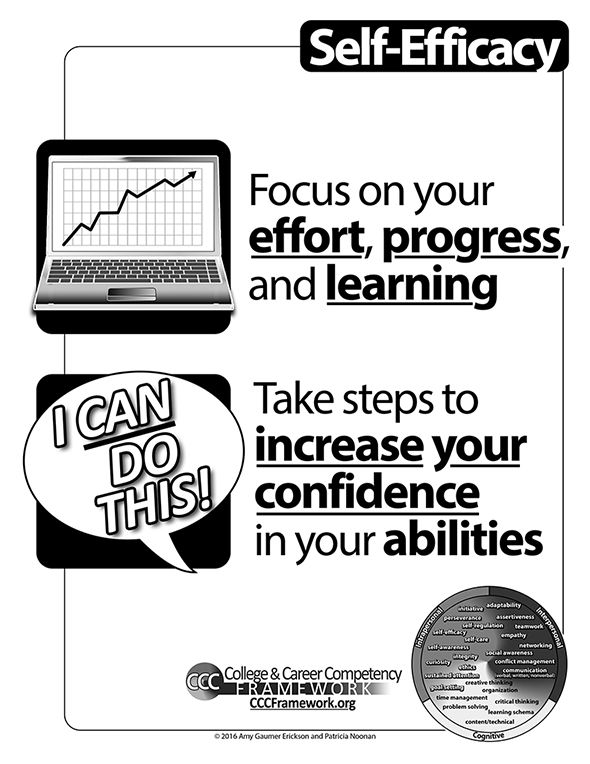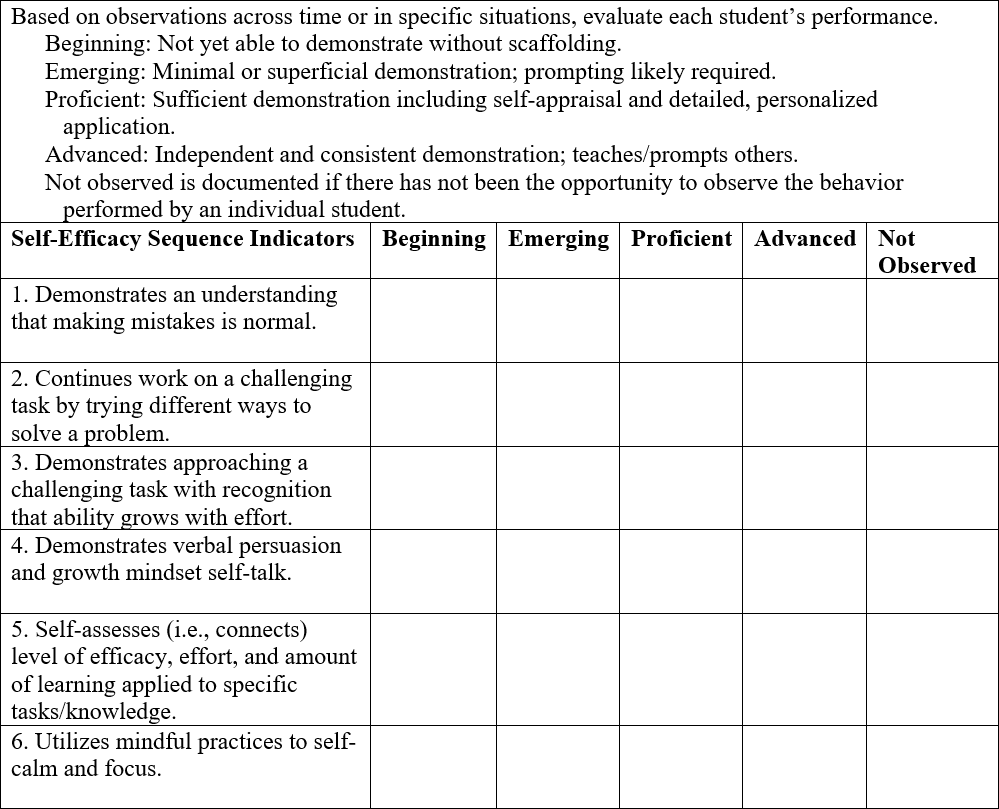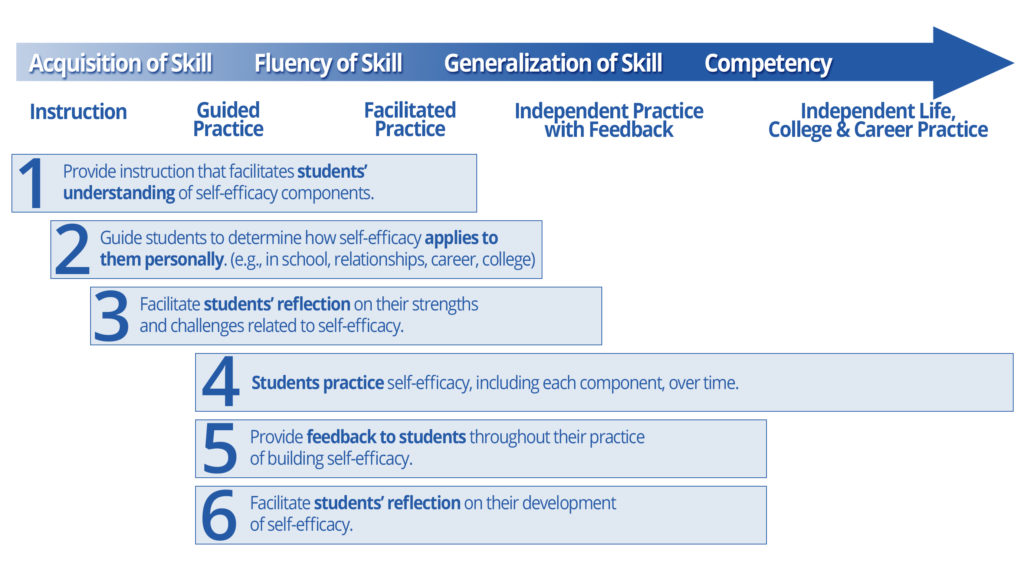Overview
- About This Module
- Why Teach Self-Efficacy?
- What is Self-Efficacy?
- The Self-Efficacy Performance-Based Observation
- The Six Instructional Criteria
Part 1: Teaching Students What Self-Efficacy Is and Why It Is Important
Part 2: Helping Students Understand Their Strengths and Challenges in Self-Efficacy
Part 3: Approaching Challenges With a Growth Mindset
Part 4: Embedding Opportunities for Students to Practice Self-Efficacy
Part 5: The College and Career Competency Framework
Overview
About This Module
This professional learning module supports educators in understanding how to support students in developing self-efficacy, an intrapersonal competency within the College and Career Competency (CCC) Framework, developed by Drs. Amy Gaumer Erickson and Patricia Noonan.
The Overview describes self-efficacy and its components, the research and impacts of the competency, and the need for embedding competency instruction across school contexts. A performance-based observation tool is included to help you assess how students use strategies to improve self-efficacy.
Parts 1–3 of this module contain instructional activities that help students understand key concepts and practice building self-efficacy. Each part includes a learning target with numerous activities that support the learning target. The Reflect and Apply portion will deepen your knowledge of self-efficacy concepts. Part 4 offers suggestions for embedding self-efficacy practice opportunities in any classroom. Finally, Part 5 will build your understanding of the College and Career Competency Framework and provide guidance for adoption and implementation of self-efficacy instruction schoolwide.
As you review Parts 1–5 of the module, record your ideas, thoughts, and actions in the Educator Workbook. This workbook contains activities, reflective questions, instructional tools, and assessments that we will refer to throughout the module. After completion of the module, submit your Educator Workbook to earn 9 Continuing Education Units (CEUs).
As you explore the instructional activities, consider how you will deliver self-efficacy instruction to your students. The “Teach Students Handouts” are located on page 11 of the Educator Workbook. Think about how you will deliver the instructional activities, noting any adaptations to meet the needs of your students.
Why Teach Self-Efficacy?
Teaching self-efficacy to students:
- increases understanding of course content, especially in math and science;
- enhances motivation;
- creates a self-reinforcing cycle of validation that supports skill development;
- increases success throughout K–12 and college; and
- increases success in the workplace.
Adolescents who lack self-efficacy are:
- less likely to take on increasingly challenging tasks and persist despite setbacks;
- less likely to view effort as necessary for improvement in or mastery of skills;
- less likely to view feedback/constructive criticism as an opportunity to learn or find lessons and inspiration in the success of others; and
- more likely to experience depression
Sources: Abar & Loken, 2010; Abun et al., 2021; Basith et al., 2020; Bembenutty, 2009; Carrol et al., 2009; Catellino et al., 2021; Cetin & Celik, 2018; Chung et al., 2021; Cleary & Chen, 2009; Cleary & Zimmerman, 2004; de Bruin et al., 2011, Dignath et al., 2008; Duckworth et al.,2011; Duckworth et al.,2016; Đurović, 2021; Graham et al., 2018; Grassinger & Dresel, 2017; Grigg et al., 2018; Guderjahn et al., 2013; Hanifah, 2021; Hardy, 2006; Komarraju & Nadler, 2013; Machmud, 2018; Meyer & Turner, 2002; Muenks & Miele, 2017; Nota et al, 2004; Oettingen & Gollwitzer, 2010; Oliver et al., 2019; Panadero et al., 2012; Paramita et al., 2020; Pintrich, 1999; Ramdass & Zimmerman, 2011; Rossi et al., 2020; Scholer et al., 2014; Ursache et al., 2012; Zimmerman, 1986; Zimmerman, 2000; Zimmerman, 2008; Zinsser et al., 2006
Watch this 4-minute overview video, created for educators, which describes self-efficacy and why we should teach it. As you watch, complete the guided notes page found on page 2 of your Educator Workbook.
When educators provide explicit self-efficacy instruction and practice opportunities, they report that students experience
- increased self-reflection/self-awareness,
- increased belief that ability grows with effort,
- improved confidence in their own abilities,
- increased openness to constructive feedback,
- improved quality and timeliness of work, and
- increased ability to reflect on successes and areas for improvement (Noonan & Gaumer Erickson, 2019).
What Is Self-Efficacy?
Self-efficacy is an intrapersonal competency that is defined as “an individual’s perceptions about their capabilities to perform at an expected level, achieve goals, and complete moderately challenging tasks” (Noonan & Gaumer Erickson, 2018, p. 23). First, consider the terms in the definition. What does the phrase “perceptions about capabilities” mean? What is an example of a “moderately challenging task?”
Self-efficacy has two components (Gaumer Erickson & Noonan, 2015). Students should receive instruction and ongoing, embedded opportunities to practice each component to build self-efficacy.

The first component is focus on your effort, progress, and learning, where students learn that if they put in effort when learning or doing something new, they can make progress even if it seems difficult initially. Of course, this doesn’t mean that they will immediately reach their objective; we help them shift their focus to the effects of their effort rather than only focusing on the overall objective or comparing themselves to their peers. In other words, when we focus on our progress, we understand how the effort that we put into a task connects to our learning. In addition, when students change their focus, it helps them celebrate personal growth and gain confidence to continue working toward the objective rather than getting discouraged because they didn’t immediately master a complex pursuit or do as well as their peers. As we explore this component, we will discuss specific ways to facilitate focusing on effort, progress, and learning, such as cultivating a growth mindset and using mistakes and setbacks as opportunities to learn and grow.
The second component is take steps to increase your confidence in your abilities. When students face challenging academic tasks, they often doubt their abilities and lack confidence, sometimes to the point of avoiding challenges altogether. However, there are several ways that we can consciously work on building our confidence or self-efficacy when we face a challenge. These strategies include reflecting on our past accomplishments before starting a new task, using mindfulness or other techniques to manage emotional and physical reactions, and taking inspiration from peers’ success. We will learn more about these strategies as we explore this component more in-depth in future activities.
Listen as Dr. Elise Heger provides an overview of the two components.
The Self-Efficacy Performance-Based Observation
How can we determine when students use strategies to improve their self-efficacy? The Self-Efficacy Performance-Based Observation(Gaumer Erickson & Noonan, 2021), found on page 14 of the Technical Guide, assesses how well students demonstrate skills to build self-efficacy. It is appropriate for students of any age and can show growth over time when combined with explicit instruction and practice. This observation tool can also be used at purposeful intervals to monitor the development of each student. Based on observations across time or in specific situations, the educator rates each student’s self-efficacious behaviors on a scale. The Technical Guide provides additional information on this assessment.

Reflect and Apply: Now that you know a little more about self-efficacy and why it is essential, as well as how to measure it, take a few minutes to reflect and consider the below questions (found in the Educator Workbook on page 3):
- What are your reasons for wanting to teach self-efficacy?
- What changes do you want to see within your students resulting from teaching self-efficacy?
The Six Instructional Criteria

These six instructional criteria (Gaumer Erickson et al., 2017) are the steps for guiding students’ development of self-efficacy. These criteria represent how we teach any content, such as helping students learn a new math concept or develop a skill they need to master. Therefore, these criteria should be applied when teaching self-efficacy.
Instructional Criterion 1 is facilitating students’ understanding of the competency. For example, if you were introducing a unit on the Civil War in a social studies class or on chemical reactions in a science class, you would start by helping the students understand each topic. Similarly, students need to understand what self-efficacy means. You can help students better understand self-efficacy by breaking down the definition and facilitating a discussion of key vocabulary within the definition (e.g., perceptions, expected level, and moderately challenging task). When students can define self-efficacy in their own words accurately, you have facilitated their understanding of self-efficacy.
Instructional Criterion 2 is helping students understand how the competency applies to them personally. For example, how will learning self-efficacy help students persist at challenging tasks? Students need to understand and believe that learning self-efficacy can help them achieve their goals. One way you can assist students in understanding how self-efficacy applies to them is to connect practicing self-efficacy with something they want or need to learn.
Instructional Criterion 3 is helping students identify their strengths and challenges related to self-efficacy. We all have areas in our lives where we feel confident and areas that challenge us. Students are no different. Helping them identify areas where they have high and low self-efficacy will increase the likelihood that they begin to apply self-efficacy strategies when learning becomes difficult.
Instructional Criterion 4 provides students with opportunities to practice both components of self-efficacy. Students need ongoing opportunities to practice both components of self-efficacy as well as strategies that support the development of each component. In other words, students should practice focusing on their effort, progress, and learning (Component 1) as well as taking steps to increase their confidence (Component 2) when they don’t have strong self-efficacy.
Instructional Criterion 5 requires that we provide students with feedback while working on their self-efficacy. As you notice students starting to apply self-efficacy, provide specific feedback that includes what they are doing well and where they might improve.
Instructional Criterion 6 requires providing students with opportunities to reflect on their development of self-efficacy, including reflecting on each component. For example, students need to consistently reflect on how their effort relates to their progress in learning as well as reflecting on how much their confidence is increasing after implementing these strategies. Asking students to reflect on how well they are addressing each component as they practice self-efficacy will help them evaluate their development of self-efficacy.
Let’s listen to educators describe how they provided self-efficacy instruction and its impact on students. Choose at least two educator reflection videos to review.


